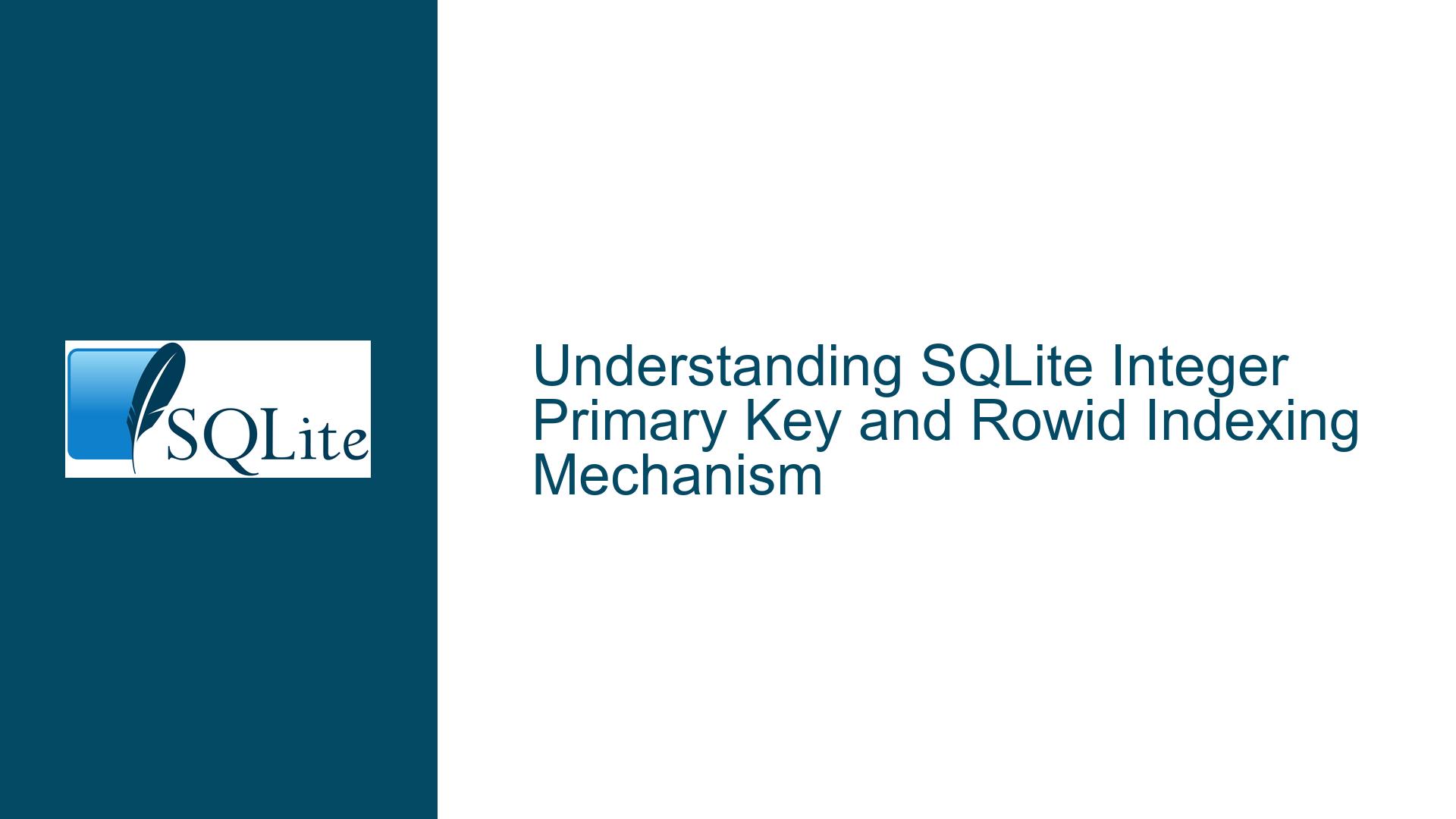SQLite Integer Primary Key and Rowid Indexing Mechanism
Integer Primary Key as an Alias for Rowid in SQLite
In SQLite, when a column is defined as an INTEGER PRIMARY KEY, it serves as an alias for the rowid. The rowid is a unique identifier for each row in a table, and it is automatically generated by SQLite unless explicitly provided. The rowid is stored as a 64-bit signed integer and is used internally by SQLite to manage and access rows efficiently. When a column is designated as an INTEGER PRIMARY KEY, SQLite does not create a separate index for this column because the rowid itself acts as the primary key. This means that the rowid is used directly to access the row data in the table’s B-tree structure, eliminating the need for an additional index.
The rowid is a fundamental concept in SQLite, and understanding its role is crucial for optimizing database performance. When a table is created without an explicit INTEGER PRIMARY KEY, SQLite automatically assigns a rowid to each row. However, this rowid is not part of the table’s persistent data and can change if rows are deleted or inserted. In contrast, when a column is defined as an INTEGER PRIMARY KEY, the rowid becomes a stable identifier that is part of the table’s persistent data. This stability is important for maintaining data integrity and ensuring efficient access to rows.
The relationship between the INTEGER PRIMARY KEY and the rowid is such that the INTEGER PRIMARY KEY column effectively becomes the rowid. This means that any query that references the INTEGER PRIMARY KEY column is directly accessing the rowid, and SQLite can use this to perform efficient lookups in the table’s B-tree structure. This direct access is one of the reasons why SQLite is known for its performance and efficiency, especially in scenarios where quick lookups are required.
Direct Rowid Access in B-tree Without Additional Indexing
When a query is executed that references an INTEGER PRIMARY KEY column, SQLite does not need to perform a binary search in an index table to find the corresponding rowid. Instead, SQLite uses the rowid directly to traverse the table’s B-tree structure and locate the row data. This is because the rowid is the key to the table row in the B-tree, and the INTEGER PRIMARY KEY column is essentially the rowid.
The B-tree structure used by SQLite is a balanced tree data structure that allows for efficient insertion, deletion, and lookup operations. Each node in the B-tree contains a number of keys and pointers to child nodes. The keys in the B-tree are used to guide the traversal of the tree, and the pointers are used to navigate to the appropriate child node. In the context of SQLite, the rowid serves as the key in the B-tree, and the pointers lead to the actual row data.
When a query such as SELECT * FROM table1 WHERE col = 123; is executed, and col is an INTEGER PRIMARY KEY, SQLite uses the value 123 as the rowid to traverse the B-tree and locate the corresponding row. This direct access to the row data is highly efficient because it avoids the need for an additional index lookup. The B-tree structure ensures that the lookup operation is performed in logarithmic time, making it suitable for large datasets.
In contrast, when a query references a column that is not the INTEGER PRIMARY KEY, SQLite may need to perform an additional index lookup to find the corresponding rowid. This is because the column is not directly tied to the rowid, and an index is required to map the column values to the rowid. The index itself is also stored as a B-tree, and SQLite uses this index to perform a binary search to find the rowid before accessing the row data in the table’s B-tree.
Implications of Rowid Stability and Indexing Strategies
The stability of the rowid when using an INTEGER PRIMARY KEY has important implications for database design and performance. Since the rowid is a stable identifier, it can be used to efficiently access rows without the need for additional indexing. This is particularly beneficial in scenarios where the database is subject to frequent insertions and deletions, as the rowid remains consistent and does not change unless explicitly modified.
However, it is important to note that the rowid is only stable when an INTEGER PRIMARY KEY is defined. If a table is created without an INTEGER PRIMARY KEY, the rowid can change if rows are deleted or inserted. This can lead to fragmentation in the B-tree structure and may impact performance. In such cases, it may be necessary to use additional indexing strategies to maintain efficient access to the data.
One common indexing strategy is to create an index on a column that is frequently used in queries. This index will map the column values to the rowid, allowing SQLite to perform efficient lookups. However, it is important to balance the benefits of indexing with the overhead of maintaining the index. Each index adds additional storage requirements and can impact the performance of insertions, deletions, and updates.
Another consideration is the use of the WITHOUT ROWID option when creating a table. This option allows you to create a table without a rowid, which can be useful in scenarios where the table has a composite primary key or where the rowid is not needed. However, tables created with the WITHOUT ROWID option have a different storage format and may require different indexing strategies.
In summary, the INTEGER PRIMARY KEY in SQLite serves as an alias for the rowid, allowing for efficient direct access to row data in the table’s B-tree structure. This direct access eliminates the need for additional indexing and can significantly improve query performance. However, it is important to consider the stability of the rowid and the implications of different indexing strategies when designing a database. By understanding the relationship between the INTEGER PRIMARY KEY, the rowid, and the B-tree structure, you can optimize your database for performance and efficiency.






